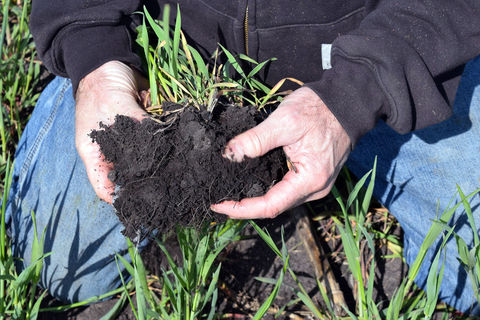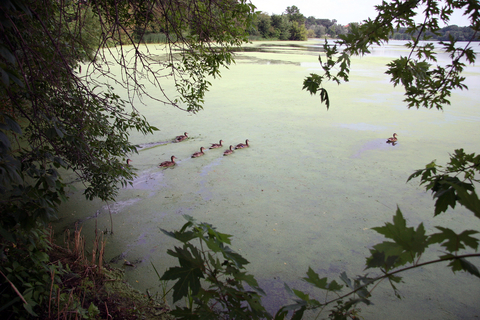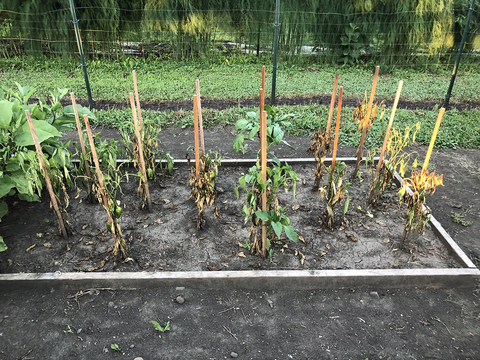Organic materials, such as compost, plant residues or manure, do wonders for garden soil and plant health. If you’ve been adding organic materials to your garden, then congratulations! You’ve been doing great work to build soil organic matter and promote soil health.
Now, let’s take it one step further to ensure that your beautiful soil organic matter remains a benefit and not a liability to plants or to the environment. After all, it is possible to have too much of a good thing — even soil organic matter. But first, let’s look at what makes soil organic matter so important.
Soil organic matter: What is it and why is it important?
Soil organic matter (SOM) is the portion of soil that is composed of living and dead things in various states of decomposition, such as plant roots and microbes. Organic (carbon-based) materials that we add to the soil, like compost or organic fertilizers, will also contribute to SOM as they are incorporated and decomposed by soil organisms. And although SOM only accounts for a small fraction of soil by volume (2-8%), it’s very important for soil and plant health. SOM is where the magic happens!
Here are some of the things that soil organic matter does for your soil:
- Provides essential nutrients for plants (such as nitrogen, phosphorus and sulfur) as it is decomposed by microbes.
- Feeds and provides habitats for diverse soil organisms, including those that help fight plant pests and diseases.
- Makes it easier for plant roots to thread through the soil to find water, air and nutrients.
- Holds water in sandy (dry) soils and helps with drainage and oxygen availability in clayey (wet, heavy) soils.
- Provides holding places for nutrients that plants need (SOM is a big part of the soil’s cation exchange capacity or CEC).
The “First National Bank” of soil
When it comes to SOM, there’s no “one size fits all” for soil. Some soils are naturally capable of retaining more SOM than others. If you have sandy soil, 2% SOM may be the upper end of what you can maintain, whereas, in clayey soils, 2% SOM is considered very low. This happens for several reasons, but one reason is that in sandy soils, there are fewer nooks and crannies for sable organic matter (humus) to accumulate.
Regardless of the level of SOM in your soil, you can think of the soil like a bank: to grow the SOM “bank account,” you need to deposit more than you remove.
“Deposits” can include plant residues, compost, cover crops, organic (carbon-based) fertilizers, and other organic materials that are decomposed by microbes.
“Withdrawals” include crop harvest, which also removes the soil nutrients used to grow those plants; heavy tillage, which speeds SOM decomposition by breaking apart soil aggregates and exposing them to oxygen; and soil erosion, which removes not only soil but also nutrients and organic residues in the soil.
In reality, the SOM “bank account” process is much more complex. But the bottom line is that over time, if the additions of organic materials are greater than the subtractions, SOM can increase.
Building SOM is a good thing, right?
“Healthy, productive soil has a good proportion of organic matter in it. You can successfully increase the quality of your soil by regularly adding organic matter.” - NRCS Backyard Conservation Tip Sheet
Yes! This is true, and many of those benefits occur with changes to soil properties like drainage and microbial diversity. However, there’s more to the story.
Although it may seem unlikely, particularly given how often gardeners are told to add organic materials to their gardens, it is possible to have too much organic matter in your soil.
Because the organic materials we add to our gardens usually contain slowly available, low levels of plant-available nutrients like nitrogen (N) and phosphorus (P), we often consider them to be low-risk for plants and for the environment. For example, yard waste compost may be about 1.3% N and about 0.4% P (as P2O) by dry weight, compared to an all-purpose garden fertilizer, which may be 10% N and 10% P or more. With such small amounts, it may not seem like compost could pose any risks to plant or soil health.
But, over time, SOM can build to the point where significantly more nutrients are available in the soil than the plants are able to use. This is when the problem occurs; excess nutrients can harm plants and pollute our lakes, rivers and groundwater (including drinking water). In some instances, these problems can occur in a single incident, such as with the overapplication of organic fertilizer or manure, but often these problems creep up over time.
Phosphorus
Although too much soil phosphorus is generally not a problem for plants (they only take what they need), it’s definitely a problem for lakes and streams. Phosphorus is what feeds excessive plant growth — including toxic algal blooms — in our freshwater lakes and rivers. And while community and home gardens do not take up much space on the landscape, they can play an outsized role in contributing to excess P in our waters.
For example, a 2019 study of phosphorus buildup in urban gardens in St. Paul found that repeat applications of compost led to an average phosphorus soil test value of 80 ppm (parts per million, Bray P test). This number by itself may not mean much, but consider that 80 ppm of P is nearly four times higher than what the UMN Extension considers “very high” available P for crop production.
When the amount of plant-available phosphorus in the soil is that high, there’s much more P there than the plants can use. And although urban gardens in the Twin Cities may only account for 0.1% of land area, the amount of P applied with compost represents one of the largest potential sources of P into local watersheds.
The most common pathway for soil-borne P to enter our waters is by being attached to small soil particles that move with runoff during rainfall. Even small amounts of runoff can move soil particles out of a garden, onto a sidewalk, and into the gutter, where they flow into a nearby storm sewer and directly into a lake or river, for example.
While soil erosion from rural areas, including farm fields, gardens and lakeshore properties (as well as forested areas), are also potential sources of P into freshwater, the very high levels of P in some gardens may make them a disproportionate source of P. In other words, even home or community gardens can become hotspots for nutrient pollution.
Nitrogen
High levels of soil nitrogen can be a problem for plants as well as for the environment. Most of the N in soil organic matter is in an organic chemical form, meaning it’s bound to carbon in large molecules that plants generally can’t use. However, when organisms decompose SOM, they transform the organic N into ammonium (NH4+) and nitrate (NO3-), the inorganic chemical forms that plants take up.
When plant roots are exposed to too much ammonium, the plants can be burned or even killed. It’s more common that applying unfinished compost or raw manure (particularly poultry manure) will lead to ammonium damage in plants, but ammonium released from very high levels of SOM can also damage plants, as was observed in an Oregon State University study of urban gardens.
When nitrate is released from SOM, it’s readily taken up by plants. High nitrate in the soil is generally not directly toxic to plants, but it can lead to excessive leafy growth and less fruiting. However, if there’s more nitrate available than the plants can use, or if there are no plants at all such as in early spring or late fall, the nitrate is easily lost with water that moves through the soil. The nitrate not only ends up in lakes and streams, where it harms fish and other aquatic organisms, but it also contaminates groundwater, which is the source of drinking water for approximately 75% of Minnesotans.
Even though a garden may be small, how it’s managed is still important. We are all part of a watershed, and the actions we all take in our gardens can have downstream consequences. We can each do our part to protect the lakes, rivers and groundwater that we value and rely on. This includes smart compost, manure and fertilizer use in our homes and community gardens. This doesn’t mean abandoning the use of compost or manure; rather, it means to take it one step further to manage plant, soil and natural resource health.
So, now what should I do?
Going forward, the best practice is to balance additions of compost or other organic materials with soil testing to truly understand how those materials are impacting your garden’s SOM. If you haven’t yet done a soil test, now is a great time to do so.
While you’re waiting for the results of your soil test, you can think about ways to help keep your garden soil and nutrients in place — similar to what many Minnesota farmers do, but on a smaller scale.
Options to reduce soil and nutrient losses include:
- Reducing the amount of tilling.
- Using cover crops.
- Mulching around crops to keep soil in place.
- Establishing a buffer around the garden to minimize runoff.
To reduce tillage in the garden, till only where you’ll be planting rather than working up an entire area. Or use hand tools rather than tillers or even experiment with no-till gardening. A garden buffer can be as simple as letting your lawn grow a little longer or more complex, such as a pollinator-friendly perennial planting.
Once you get your soil test results, consider whether or not you need to adapt your management going forward.
Here’s an example. We have an old farmhouse on several acres next to what used to be a dairy farm. For decades, our field was the recipient of manure and our silt loam soil is lovely and rich with SOM. Our soil test found that we had very high levels of phosphorus and potassium (off-the-charts high!), but some nitrogen was recommended for optimum plant growth. As a personal preference, I like to use organic nutrient sources in my garden, so rather than using lots of compost, I now use a combination of cover crops (with legumes for N) and blood meal, which is around 13% N, only 2% P (as P2O5) and 1% K (as K2O). If I were to use an inorganic fertilizer, I’d probably use urea, which is around 46% N and has no P or K.
This may all sound rather complicated, but the bottom line is that adding organic materials to your garden — in combination with soil testing — is an ideal way to promote soil, plant and environmental health.
Here are a few more resources to help you along the way:
- U of MN Soil Testing Laboratory
- Video: Why test your soil?
- Quick guide to fertilizing plants
- Cover crops and green manures in home gardens
- Soil organic matter in cropping systems
- Organic Matter and Soil Amendments - University of Maryland
Rosen, C. and Bierman, P., 2005. Maintaining Soil Fertility in an Organic System
Small, G. et al., 2019. “Excess phosphorus from compost application in urban gardens created potential pollution hotspots”. Environmental Research Communications, 1 091007. https://iopscience.iop.org/article/10.1088/2515-7620/ab3b8c/pdf
Pokorney, K. Study shows some urban gardens contain too much organic matter. Accessed 3/2021.
Minnesota Pollution Control Agency. The state of groundwater. Accessed 3/2021.




